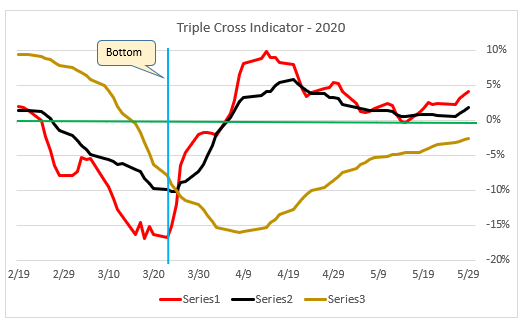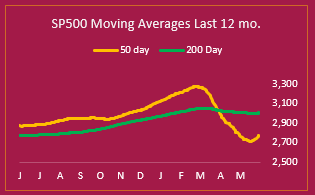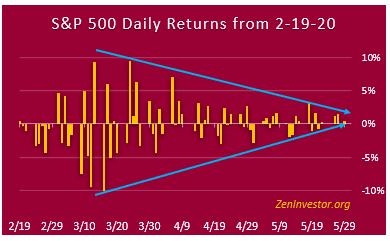The week just past
It was another strong week, up 3.2% on the S&P 500. It was a repeat of last week's 3.2% gain and it accomplished it in just 4 trading days after Monday's holiday. Will we follow in the footsteps of the 1990's Chicago Bulls and have a three-peat?
Sports fans will recall that the first three-peat made basketball history. Then Michael Jordan retired to pursue a baseball career. That didn't work out, so he returned to the Bulls and led the team to a second three-peat. It will take a long time for that winning streak to be surpassed.
Last week we had two big up days (Tuesday and Wednesday), one down day (Thursday) and one mediocre day.. The net result was a gain of 3.2% for the week.
The Triple Cross Indicator
The Triple Cross chart plots three moving average crossovers - short, intermediate, and long. The idea is to give you a sense of market momentum at these three time frames.
In a normal upward trending market, all three lines will be above zero. In a bear market they will be below zero. In between, the short moving average (red line) acts like the canary in the coal mine and warns of possible trouble ahead. This line is very twitchy, so only the most active traders should act on it.
The intermediate moving average (black line) isn't as twitchy as the red line. It avoids some of the whipsaws that the red line can cause. When the black line moves above or below zero it's a good indication that the intermediate trend in the market has changed.
The long moving average (brown line) serves as confirmation that what the other two lines are saying is sustainable. Each investor must decide for themselves how to use the information provided by the three moving average crossovers.
The way I interpret this chart today is that the rally from March 23 is losing momentum but is still going.
The Death Cross
Next we have the dreaded Death Cross. Note the uptick in the 50 day moving average. But the 200 day is still in decline. We are still in the grip of the death cross.
The Compression of Daily Volatility
Lastly, we have the compression of daily market swings. Three months ago we were seeing daily swings of 6% to as high as 10% in the market. Now we're down to 1% or 2% daily swings with an occasional 3% day. Are we headed for another "Minsky Moment"?
"A Minsky Moment is based on the idea that periods of bullish speculation, if they last long enough, will eventually lead to crisis, and the longer the speculation occurs, the more severe the crisis will be. Hyman Minsky's main claim to economic theory fame was centered around the concept of the inherent instability of markets, especially bull markets. He felt that extended bull markets always end in epic collapses.
Minsky postulated that an abnormally long bullish economic growth cycle will spur an asymmetric rise in market speculation that will, eventually, result in market instability and collapse. A Minsky Moment crisis follows a prolonged period of bullish speculation, which is also associated with high amounts of debt taken on by both retail and institutional investors." -Investopedia
Final Thoughts
This is the big question, at least in my mind: Putting Minsky aside for a moment, are we headed for a Wile E. Coyote moment in the stock market? For you youngsters out there, "Wile E. Coyote and the Road Runner are a duo of cartoon characters from the Looney Tunes cartoons.
In each episode, the cunning, insidious and constantly hungry Coyote repeatedly attempts to catch and subsequently eat the Road Runner, a fast-running ground bird, but is never successful. Instead of his animal instincts, the Coyote uses absurdly complex contraptions to try to catch his prey, which comically backfire, with the Coyote often getting injured in slapstick fashion. Many of the items for these contrivances are mail-ordered from a variety of companies that are all named Acme.
One running gag involves the Coyote falling from a high cliff. After he goes over the edge, the rest of the scene, shot from a bird's-eye view, shows him falling into a canyon so deep, that his figure is eventually lost to sight. This is followed, a second or two later, by the rising of a dust cloud from the canyon floor as the Coyote hits." - Wikipedia
The last time we had a Wile E. Coyote moment in the market was in 1998-2000, which was a period that is similar to today in the sense that investors back then didn't care about fundamentals like earnings or valuations. They only cared about clicks and eyeballs. Investors today only seem to care about what the Fed is doing.
Today we are witnessing the same disregard for fundamentals. The bulls of today, like the Chicago Bulls of the 1990's may manage a three-peat. And maybe even a second one. But my instincts tell me that the worst of the pandemic and the economic damage it has wrought are not over yet. Listen to what Citibank has to say:
‘We definitely feel that the markets are way ahead of reality. We really are telling every client to tap the market if they can because we think the pricing now couldn’t get any better.’
The floor seems to be somewhere around 2500, thanks to Federal Reserve largess.
I have other ideas to share, and I'm going to put them in my upcoming Monthly Intelligence Report. Check it out here.





Nice article and analysis! I used to go to a Theatre in Birmingham, MI as a kid…our Mother would give us $0.25 for the Saturday showtime and a Slo-Pok or a Bonamo Taffy…so understand the Roadrunner series explicitly. I do agree the market is crazy right now. Living my golden years, what I have seen here makes no sense to me…but you need to let the market come to you (a Zen Master shared that with me once)…and not get to upset with the goings on.